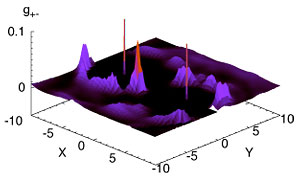- Green Solvent Media
- Energy Storage
- Multi-domain Proteins
Green Solvent Media
Solvation and Chemical Reactions





Room-temperature ionic liquids (RTILs), consisting of bulky organic cations paired with various organic and inorganic anions, are the object of intensive scrutiny because of their important implication as an environmentally-benign alternative to organic solvents used in synthesis, catalysis, and extraction. Employing molecular dynamics (MD) computer simulations in the atomistic representation, we study various solvation problems, e.g., solubility of toxic dioxin and time-dependent fluorescence of dyes, and chemical reactions, e.g., electron transfer and SN1 reactions, in these media and their mixtures with normal solvents, such as water, alcohols and carbon dioxide. Our primary focus is to understand the influence of RTIL environments on the structure, free energetics and dynamics associated with these processes with special attention paid to the aspects shared by and the contrasts with normal polar solvents. We also study ion pair interactions and related vibrational spectroscopy via ab initio methods to interpret experimental results in collaboration with the Kiefer group.
Further reading
Y. Shim and H. J. Kim, MD Study of Solvation in the Mixture of a Room-Temperature Ionic Liquid and CO2, J. Phys. Chem. B 114, 10160–10170 (2010).
N. R. Dhumal, H. J. Kim and J. Kiefer, Molecular Interactions in 1-Ethyl-3-methylimidazolium Acetate Ion Pair: A Density Functional Study, J. Phys. Chem. A 113, 10397–10404 (2009).
Y. Shim and H. J. Kim, Electron Transfer Reactions in Supercritical Water, J. Phys. Chem. B 112, 585–594 (2008).
Y. Shim, D. Jeong, S. R. Manjari, M. Y. Choi, and H. J. Kim, Solvation, Solute Rotation and Vibration Relaxation, and Electron Transfer Reactions in Room-Temperature Ionic Liquids, Acc. Chem. Res. 40, 1130–1137 (2007).
Dynamic Heterogeneity and Glassy Behaviors
Despite strong electrostatic interactions among constituent ions, RTILs show interesting characteristics of organic glasses, for example, marked deviations from exponential relaxation dynamics and breakdown of the Stokes-Einstein relation. In collaboration with the Choi and Jung groups, we develop coarse-grained models consistent with atomistic descriptions and use them to analyze glassy behaviors of RTILs via MD. Our current thrust is to understand dynamic heterogeneity associated with, among others, solvation and its potential link to structure.
Further reading
D. Jeong, M. Y. Choi, H. J. Kim and Y. Jung, Fragility, Stokes-Einstein Violation and Correlated Local Excitations in a Coarse-grained Model of an Ionic Liquid, Phys. Chem. Chem. Phys. 12, 2001–2010 (2010).
D. Jeong, M. Y. Choi, Y. Jung and H. J. Kim, 1/f Spectrum and Memory Function Analysis of Solvation Dynamics in a Room-Temperature Ionic Liquid, J. Chem. Phys. 128, 174504 (2008).
Y. Shim, D. Jeong, M. Y. Choi, and H. J. Kim, Rotational Dynamics of a Diatomic Solute in the Room-Temperature Ionic Liquid 1-Ethyl-3-Methylimidazolium Hexafluorophosphate, J. Chem. Phys. 125, 061102 (2006).
Novel Materials
Another system we are interested in is gelatinous materials that can form when RTILs are mixed with carbon nanotubes. Because of their unique properties, i.e., good thermal stability, non-volatility and high conductivity, these so-called “bucky gels” have many potential applications, including electrodes and actuators. By using MD, we investigate the gelation and actuation mechanisms of these systems at the molecular level.